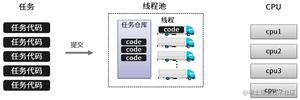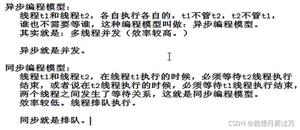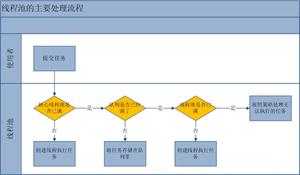【图灵学院10】高并发之java线程池源码分析

1. 提纲
1)线程池的模块结构
2)示例&原理解析
2. 问题
1)线程池包含哪些东西
2)线程池的运作原理
3)调度线程池的运作原理
4)线程池怎么实现FixRate,FixDelay,他们之间的区别
5)任务怎么取消
3. 源码解析
3.1 线程池框架
接口简介:
java.util.concurrent.Executor:执行器,执行方法
java.util.concurrent.ExecutorService:(执行服务)包含服务的生命周期
java.util.concurrent.ScheduledExecutorService:(调度相关的服务)
辅助类:
java.util.concurrent.Executors:
核心实现类:
java.util.concurrent.ThreadPoolExecutor:(普通的线程池实现类)
java.util.concurrent.ScheduledThreadPoolExecutor:(调度的核心实现类)
java.util.concurrent.ForkJoinPool
完成服务:
java.util.concurrent.CompletionService:
java.util.concurrent.ExecutorCompletionService:
3.2 ThreadPoolExecutor源码剖析
1)构造器
核心数量,任务队列容器,存活时间,线程工厂,处理器
ThreadPoolExecutor.execute()方法源码
public void execute(Runnable command) { if (command == null)
throw new NullPointerException();
/*
* Proceed in 3 steps:
*
* 1. If fewer than corePoolSize threads are running, try to
* start a new thread with the given command as its first
* task. The call to addWorker atomically checks runState and
* workerCount, and so prevents false alarms that would add
* threads when it shouldn't, by returning false.
*
* 2. If a task can be successfully queued, then we still need
* to double-check whether we should have added a thread
* (because existing ones died since last checking) or that
* the pool shut down since entry into this method. So we
* recheck state and if necessary roll back the enqueuing if
* stopped, or start a new thread if there are none.
*
* 3. If we cannot queue task, then we try to add a new
* thread. If it fails, we know we are shut down or saturated
* and so reject the task.
*/
int c = ctl.get();
if (workerCountOf(c) < corePoolSize) {
if (addWorker(command, true))
return;
c = ctl.get();
}
if (isRunning(c) && workQueue.offer(command)) {
int recheck = ctl.get();
if (! isRunning(recheck) && remove(command))
reject(command);
else if (workerCountOf(recheck) == 0)
addWorker(null, false);
}
else if (!addWorker(command, false))
reject(command);
}
ThreadPoolExecutor.runWorker()方法源码
final void runWorker(Worker w) { Thread wt = Thread.currentThread();
Runnable task = w.firstTask;
w.firstTask = null;
w.unlock(); // allow interrupts
boolean completedAbruptly = true;
try {
while (task != null || (task = getTask()) != null) {
w.lock();
// If pool is stopping, ensure thread is interrupted;
// if not, ensure thread is not interrupted. This
// requires a recheck in second case to deal with
// shutdownNow race while clearing interrupt
if ((runStateAtLeast(ctl.get(), STOP) ||
(Thread.interrupted() &&
runStateAtLeast(ctl.get(), STOP))) &&
!wt.isInterrupted())
wt.interrupt();
try {
beforeExecute(wt, task);
Throwable thrown = null;
try {
task.run();
} catch (RuntimeException x) {
thrown = x; throw x;
} catch (Error x) {
thrown = x; throw x;
} catch (Throwable x) {
thrown = x; throw new Error(x);
} finally {
afterExecute(task, thrown);
}
} finally {
task = null;
w.completedTasks++;
w.unlock();
}
}
completedAbruptly = false;
} finally {
processWorkerExit(w, completedAbruptly);
}
}
3.3 ScheduledThreadPoolExecutor
1)
2)FixRate和FixDelay的区别
/*** Sets the next time to run for a periodic task.
*/
private void setNextRunTime() {
long p = period;
if (p > 0)
time += p;
else
time = triggerTime(-p);
}
FixRate严格按照设定的时间
FixDelay按照上一个线程执行完成的时间间隔
FixRate: 21:40,21:41,21:42
FixDelay:21:40,21:43
void reExecutePeriodic(RunnableScheduledFuture<?> task) { if (canRunInCurrentRunState(true)) {
//此处没有捕获异常,如果单个任务发生异常,会导致后续任务无法继续执行
super.getQueue().add(task);
if (!canRunInCurrentRunState(true) && remove(task))
task.cancel(false);
else
ensurePrestart();
}
}
以上是 【图灵学院10】高并发之java线程池源码分析 的全部内容, 来源链接: utcz.com/z/394539.html







